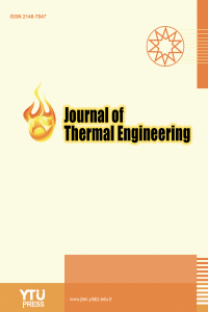Experimental investigation of impact of fire size on heat transfer and flame behavior of initial stage unsteady pool fires inside a cubical enclosure
Experimental investigation of impact of fire size on heat transfer and flame behavior of initial stage unsteady pool fires inside a cubical enclosure
Unsteady Growing Pool Fire, Heat Flux Flame Behavior, Mass Loss Rate, Enclosure, Ceiling Duct,
___
- RReferences
- Hamins A, Kashiwagi T, Buch RR. Characteristics of pool fire burning. ASTM Spec Tech Pub 1996;1284:1541. [CrossRef]
- Babrauskas V. Free burning fires. Fire Safe J 1986;11:3351. [CrossRef]
- Joulain P. The behavior of pool fires: state of the art and new insights. Symp Comb Proc 1998;27:26912706. [CrossRef]
- Quintiere JG. Fire behavior in building compartments. Proc Comb Inst 2002;29:181193. [CrossRef]
- Drysdale D. An introduction to fire dynamics. 3rd ed. England:John Wiley & Sons; 2011[CrossRef]
- Mathur A, Vikas DH, Kale SR. An Experimental Study on Burning of Vertical Cloth Panels. Fire Saf Sci 2011;10:485498. [CrossRef]
- Babrauskas V. Estimating large pool fire burning rates. Fire technol, 1983;19:251261. [CrossRef]
- Bundy MF, Hamins AP, Johnsson EL, Kim SC, Ko G, Lenhert DB. Measurements of heat and combustion products in reduced-scale ventilation-limited compartment fires. Tech Note (NIST TN);Gaithersburg: Natl Inst Stand Technol; 2007. [CrossRef]
- Lock A, Bundy M, Johnsson EL, Hamins A, Ko GH, Hwang CH,et al. Experimental study of the effects of fuel type, fuel distribution, and vent size on full-scale under ventilated compartment fires in an ISO 9705 room. Tech Note (NIST TN);Gaithersburg:Natl Inst Stand Technol; 2008. [CrossRef]
- 1WK C, WL C. Experimental studies on forced-ventilated fires. Fire Sci Technol 1993;13:7187. [CrossRef]
- Babrauskas V. Heat release rates. In: Hurley MJ editor. SFPE Handbook of Fire Protection Engineering.5th ed. New York; Springer: 2016. p.799904.
- Liu J, Chen M, Lin X, Yuen R, Wang J. Impacts of ceiling height on the combustion behaviors of pool fires beneath a ceiling. J Therm Anal Calorim 2016;126:881889. [CrossRef]
- Andrews GE, Ledger J, Phylaktou HN. Pool fires in a low ventilation enclosure. Inst Chem Eng Symp Ser; UK: Inst Chem Eng; 2000.p. 171184
- Pretrel H, Suard S, Audouin L. Experimental and numerical study of low frequency oscillatory behaviour of a large-scale hydrocarbon pool fire in a mechanically ventilated compartment. Fire Saf J 2016;83:3853. [CrossRef]
- Mense M, Pizzo Y, Pretrel H, Loraud JC, Porterie B. Experimental parametric study on low-frequency oscillating behaviour of pool fires in a small-scale mechanically-ventilated compartment.Journal of Physics: Conference Series: IOP Publishing ;2018 .[CrossRef]
- Mense M, Pizzo Y, Prétrel H, Lallemand C, Porterie B. Experimental and numerical study on low-frequency oscillating behaviour of liquid pool fires in a small-scale mechanically-ventilated compartment. Fire Saf J 2019;108:102824. [CrossRef]
- Zhang S, Ni X, Zhao M, Zhang R, Zhang H. Experimental study on the characteristics of wood crib fire in a confined space with different ventilation conditions. J Therm Anal Calorim 2015;120:13831391. [CrossRef]
- Babrauskas V. Estimating room flashover potential. Fire Technol 1980;16:94103. [CrossRef]
- Liu Q, Ma Q, Zhang H, Yang R, Wei D, Lin CH. Experimental study on n-heptane pool fire behavior under dynamic pressure in an altitude chamber. J Therm Anal Calorim 2017;128:11511163. [CrossRef]
- Chandra AS, Reddy PN, Harish R. Natural ventilation in a lege space with heat source: CFD visualization and taguchi optimization. J Therm Eng 2022;8:642655. [CrossRef]
- Sereir T, Missoum A, Mebarki B, Elmir M, Douha M. Effect of the position of the hot source on mixed convection in a rectangular cavity. J Therm Eng 2021;8:538550. [CrossRef]
- Karbhari VM. Introduction: the use of composites in civil structural applications. Durability of composites for civil structural applications. 1st ed. Woodhead Publishing: 2007. p. 110. [CrossRef]
- Brohez S, Saladino D, Perelli M, Experimental and Numerical Study of Heptane Pool Fire. Chem Eng Trans 2022,91:223228.
- Wang J, Jiao Y, Shi L, Xie Q, Li G, Liu J, et al. An experimental and non-dimensional study on the vertical temperature distribution of a sealed ship engine room fire. Ocean Eng 2018;165:2233. [CrossRef]
- Sudheer S, Saumil D, Prabhu SV. Physical experiments and Fire Dynamics Simulator simulations on gasoline pool fires. J Fire Sci 2013;31:309329. [CrossRef]
- Loo AX, Coppalle A, Yon J, Aîné P. Time-dependent smoke yield and mass loss of pool fires in a reduced-scale mechanically ventilated compartment. Fire Saf J 2016;81:3243. [CrossRef]
- Jiang P, Lu SX. Pool fire mass burning rate and flame tilt angle under crosswind in open space. Procedia Eng 2016;135:261274. [CrossRef]
- Woods JA, Fleck BA, Kostiuk LW. Effects of transverse air flow on burning rates of rectangular methanol pool fires. Combust Flame 2006;146:379390. [CrossRef]
- Delichatsios MA, Silcock GW. Fully involved enclosure fires: effects of fuel type, fuel area and geometry. Fire Saf Sci 2003;7:59[CrossRef]
- Yayın Aralığı: 6
- Başlangıç: 2015
- Yayıncı: YILDIZ TEKNİK ÜNİVERSİTESİ
Determination of optimum insulation thickness in submarines
Savaş DURMAZ, Andaç Batur ÇOLAK, Hatice MERCAN, Ahmet Selim DALKILIÇ
Ahmed ALAMI, Lala RAJAOARISOA, Mohammed-hichem BENZAAMA, Abdeldjalil BENBAKHTI
Heat transfer enhancement of electronic devices by using flexible printed circuit boards
Mustafa EMAD, Sattar ALJABAIR, Ahmed Abdulnabi IMRAN
Analysis of solar water desalination using hybrid nanofluids: An experimental study
Ajit AJİT, Harshit PANDEY, Naveen Kumar GUPTA
Design and development of air ventilated air bed for hospitalized patients
Darshan KARANJE, Shivroop PATIL, Shivraj GURSAL, Prafulla HATTE
Huda Majid HASAN, Basma Abbas ABDULMAJEED
Astick BANERJEE, Sanat Kumar MAHATO, Krishnendu BHATTACHARYYA, Sohita RAJPUT, Ajeet Kumar VERMA, Ali J. CHAMKHA
Experimental study on a novel waterless solar collector
Asaad H. SAYER, Wed AL-GRAITI, Hameed B. MAHOOD, Hameed B. MAHOOD, Alasdair N. CAMPBELL
Amina BENABDERRAHMANE, Ahmed Kadhim HUSSEIN, Obai YOUNIS, Abdelylah BENAZZA
